
Hearty stews are on the menu whether you live in Durham or Dublin, Smithfield or San Juan, Apex or Acapulco, Morrisville or Mumbai. All over the world, people toss simple ingredients into one pot to make the ultimate comfort food.
Following are cozy recipes from new cookbooks. These main courses are perfect for chasing any fall nip in the air. Share the warmth with bowls of rich, thick goodness!
 Ciderhouse Cookbook
Ciderhouse Cookbook
127 Recipes That Celebrate the Sweet, Tart, Tangy Flavors of Apple Cider
By Jonathon Carr and Nicole Blum
with Andrea Blum
Published by Storey Publishing
Irish Beef Stew with Hard Cider
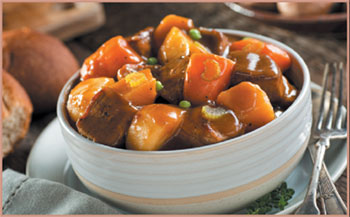 Apples and beef are not a widely known combination, but the hard cider serves to winningly brighten this iconic stew. The original version of this recipe was handed down from Jonathan's Irish grandmother to his mother, in order to keep his father happy and well fed. In the olden days, the onions would have been kept whole and the browning may have been omitted, but we recommend taking the time for it - you will be very pleased with the results.
Apples and beef are not a widely known combination, but the hard cider serves to winningly brighten this iconic stew. The original version of this recipe was handed down from Jonathan's Irish grandmother to his mother, in order to keep his father happy and well fed. In the olden days, the onions would have been kept whole and the browning may have been omitted, but we recommend taking the time for it - you will be very pleased with the results.
5 tablespoons high-heat sunflower oil
1-1/4 pounds stewing beef, cut into 1- to 2-inch pieces
1 cup dry hard cider
3 medium onions, peeled and quartered
8 medium potatoes (a waxy variety, not a floury one), peeled and cut in half
4 sticks celery, trimmed and cut into 2- to 3-inch lengths
2 carrots, peeled, halved lengthwise, and cut into
2- to 3-inch pieces
1-1/2 teaspoons kosher salt
1/4 teaspoon freshly cracked black pepper
1/4 teaspoon finely chopped dried rosemary
1/4 teaspoon rubbed sage
1/4 teaspoon finely chopped dried thyme
1 bay leaf
6 cups water or stock
1 scallion, thinly sliced, for garnish
Sour cream mixed with horseradish, for garnish (optional)
Serves 4-6
Note: All the ends and peelings from the stew vegetables can be used to make a fine stock for your next soup!
Heat 3 tablespoons of the oil in a stew pot over high heat. When the oil starts to smoke, add the beef and brown well, turning occasionally, about 10 minutes.
Turn off the heat and add 1/2 cup of the cider to deglaze the brown bits on the bottom of the pot. Stir well, scraping the sides and bottom. Transfer the beef and brown sauce to a bowl and set aside.
Add the remaining 2 tablespoons of oil to the pot and heat over high heat. Add the onions and brown for 5 minutes, stirring occasionally. Add the potatoes, celery and carrots, and brown for 5 minutes longer. Add the remaining 1/2 cup cider to deglaze the pot and stir well.
Add the salt, pepper, rosemary, sage, thyme and bay leaf, then pour in the water. Add the beef and brown sauce. Stir gently to mix well. Bring the pot to a boil, then reduce the heat to low and simmer until the meat is fork-tender and falls apart easily, about 2 hours. Keep the lid on for a brothy stew or off to let the broth reduce.
Remove the bay leaf. Taste and adjust the seasoning as desired. Ladle into serving bowls. Garnish with the scallions and a dollop of sour cream mixed with horseradish, if desired.
All recipes used with permission from Storey Publishing.
 Coconuts and Collards
Coconuts and Collards
Recipes and Stories from Puerto Rico
to the Deep South
By Von Diaz
Published by University Press of Florida
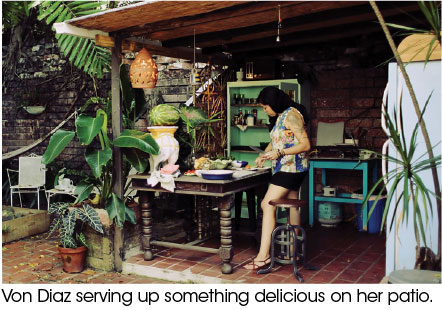 Asopao de Pollo
Asopao de Pollo
(Chicken and Rice Stew)
When we were really broke, Mami often made asopao de pollo, partly because it uses just a handful of ingredients that we always had on hand and partly because it was filling and deeply satisfying. It reminds me of Southern chicken and rice. This recipe can also easily be made with shrimp by substituting shrimp stock for the chicken stock and shrimp for the chicken and adjusting the cooking time for the shrimp to just a few minutes. Mami never made asopao with capers, olives or peas, so I've listed them as optional.
Serves 6
1 cup basmati rice
1 tablespoon olive oil
1/4 cup sofrito (recipe follows)
1 large tomato, peeled and chopped
1/2 cup tomato sauce
2 bay leaves
6 fresh culantro leaves (available at international markets), finely chopped*
1-1/2 teaspoons salt
5 cups chicken stock
1-1/2 pounds boneless chicken breasts, cut into
1/2-inch pieces
2 cups frozen or fresh green peas (optional)
1-1/2 teaspoons capers in brine, drained (optional)
8 pimento-stuffed manzanilla olives (optional)
Cracked black pepper
Avocado slices
Rinse the rice in several changes of water and let soak while you prepare the remaining ingredients.
In a large saucepan, heat the oil over medium-high heat. Add the sofrito and cook for about 7 minutes, stirring frequently, until the mixture starts to darken and the liquid is mostly evaporated. Add the chopped tomato and tomato sauce and cook for another 5 minutes, or until thickened and slightly darkened.
Drain the rice, then add it to the pot along with the bay leaves, culantro, salt and stock, stirring well. Bring to a boil, then lower the heat to low, cover the pot, and simmer for about 10 minutes, until the rice expands and the stew thickens.
Carefully remove the lid and add the chicken. Stir well, cover, and continue to cook for 7 more minutes, or until the chicken is cooked through.
Add the green peas, capers and olives, if using, and stir
well. Cook for another 3 minutes, then season with more salt if needed and some pepper.
Serve with avocado slices.
*Culantro is a popular herb across Latin America, the Caribbean and Asia. Culantro's aroma and flavor is similar to but more assertive than its cousin cilantro, although its appearance is much different.
Sofrito
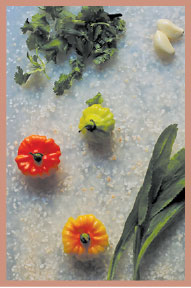
What I'm calling sofrito is sometimes referred to as recaito, the distinction being whether or not it includes tomato. But the basic ingredients are the same. It is the No. 1 backbone of Puerto Rican cooking and can be adapted in a number of ways depending on the dish. Abuelitas and tias alike often keep sofrito in the freezer stored in repurposed plastic margarine containers or frozen into cubes and saved in zip-top bags. It's best used within a week if kept in the refrigerator but can be frozen for up to 6 months. Plop it in the pan straight out of the freezer to save time defrosting it.
Makes 3 cups
1 medium red bell pepper, seeded and quartered
3 aji dulce chiles (sweet peppers), seeded and roughly chopped
6 large garlic cloves, peeled
1 large yellow onion, coarsely chopped
6 fresh culantro leaves
6 fresh cilantro leaves and stems, coarsely chopped
Put the bell pepper, aji dulce chiles and garlic cloves in the bowl of a food processor and blend into a smooth puree, scraping the sides halfway through to incorporate fully.
Add the onion and pulse 5 to 7 times, until the mixture is again blended into a smooth puree.
Add the culantro and cilantro and pulse 5 or 6 more times, until the stems and leaves are minced and you have a loose paste.
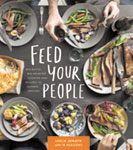 Feed Your People
Feed Your People
Big-Batch, Big-Hearted Cooking and Recipes to Gather Around
By Leslie Jonath and 18 Reasons
Published by powerHouse Books
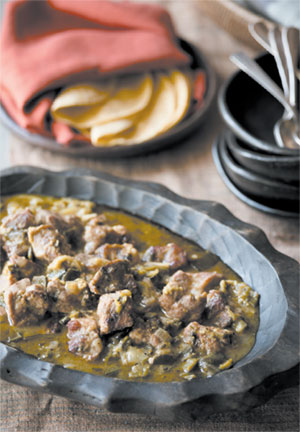 Grandma Salazar's Chile Verde
Grandma Salazar's Chile Verde
San Fancisco chef and restaurateur Traci Des Jardins has been enjoying this robust stew all of her life. A native Californian, she grew up with Spanish-speaking grandparents and calls dishes like this one her soul food. Her grandmother, a dedicated home cook who was born in Mexico, made this chile verde frequently for family gatherings and also taught her young granddaughter how to make it. It was just one of the many family recipes that has inspired Traci's lifelong passion for cooking and bringing people together around the table - in her restaurants, at home and at countless events in support of food equity.
For this homey dish, Traci uses a pork butt, which is a delicious and relatively inexpensive way to feed a crowd of family and friends. She combines it with tomatillos, cilantro, chiles and other staples of her traditional family pantry and then braises it slowly to yield a flavorful broth and lots of tender meat ideal for pairing with warm tortillas.
Make ahead
The stew can be refrigerated for up to 3 days or frozen for up to 1 month.
Equipment
Two half sheet pans; one or two large non-reactive (not cast iron) soup pots or Dutch ovens.
Big batch notes
Do not crowd the pork when browning it or it will give off too much steam, which will prevent it from developing good color.
Serving
Start with tortilla chips and guacamole, set out one or more salsas, a stack of warm tortillas, and a green salad with the stew, and offer ice cream with cajeta for dessert.
Ingredient notes
If you want to make this dish gluten-free, it is fine to omit the flour. Nothing is needed in its place.
Single batch makes 10 servings
Double batch makes 20 servings
| SINGLE BATCH | DOUBLE BATCH |
| Boneless pork butt (shoulder) | |
| 4 pounds | 8 pounds |
| Kosher salt | |
| 1-1/2 tablespoons | 3 tablespoons |
| Freshly ground black pepper | |
| All-purpose flour | |
| 2 tablespoons | 1/4 cup |
| Vegetable oil | |
| 2 tablespoons | 1/4 cup |
| Tomatillos, husks removed, rinsed and quartered | |
| 3 pounds | 6 pounds |
| Anaheim or poblano chiles, stemmed and cut into 1/2-inch pieces | |
| 1 pound | 2 pounds |
| Yellow onions, cut into 1/2-inch pieces | |
| 2 | 4 |
| Garlic cloves, roughly chopped | |
| 6 | 12 |
| Cilantro, leaves only, coarsely chopped | |
| 1 bunch | 2 bunches |
| Ground cumin | |
| 1 teaspoon | 2 teaspoons |
| Dried oregano | |
| 1/2 teaspoon | 1 teaspoon |
| Chicken stock, or as needed | |
| 3 cups | 6 cups |
Trim the pork of excess fat and cut into 1-1/2inch chunks. Spread the pork on half sheet pans and season generously with the salt and several grinds of pepper. Sprinkle with the flour and toss until coated.
Heat a large Dutch oven(s) over medium-high heat.
When the pan is hot, add the oil and, working in batches, fry the pork until golden brown on all sides. Using tongs, transfer to a sheet pan.
When all of the meat has been browned, add the tomatillos, chiles, onions and garlic to the pot(s) and reduce the heat to low. Cook until the vegetables are soft, 10 to 15 minutes.
Return the meat to the pot and add the cilantro, cumin and oregano. Pour in enough stock just to cover the meat, raise the heat to medium-high, and bring to a gentle boil.
Reduce the heat to a simmer, cover and cook, stirring occasionally, until the pork is tender, about 2 hours. Serve hot.
 The Complete Indian Instant Pot Cookbook
The Complete Indian Instant Pot Cookbook
130 Traditional
and Modern
Recipes
By Chandra Ram
Published by Robert Rose
Matar With Feta
(Stewed Peas and Cheese)
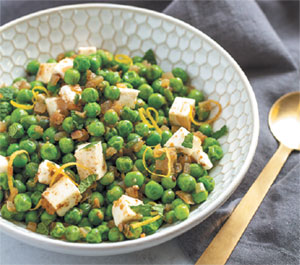 Traditional matar paneer - or peas and cheese, as we called it growing up - has a dark, rich tomato gravy and cubes of paneer amid a bowl of stewed peas. Think of this dish as traditional matar paneer's cousin who spent a summer backpacking through Greece. This version is light on the gravy so you taste more of the clean, sweet flavors of the peas, accentuated by the light, floral flavor of coriander. Cubed feta adds a little tanginess and the lemon and mint give it a green brightness.
Traditional matar paneer - or peas and cheese, as we called it growing up - has a dark, rich tomato gravy and cubes of paneer amid a bowl of stewed peas. Think of this dish as traditional matar paneer's cousin who spent a summer backpacking through Greece. This version is light on the gravy so you taste more of the clean, sweet flavors of the peas, accentuated by the light, floral flavor of coriander. Cubed feta adds a little tanginess and the lemon and mint give it a green brightness.
Serves 6
2 tablespoons ghee or coconut oil
1 onion, minced
1 tablespoon ground coriander
1 tablespoon ground cumin
1 serrano chile, finely chopped
1 tablespoon grated lemon zest
1/2 cup water
1 pound frozen peas
7 ounces feta cheese, cubed
1/4 cup finely chopped mint leaves
Using the sauté function on high, heat the ghee in the inner pot for about 1 minute, until shimmering. Add the onion and stir to combine. Add the coriander and cumin and cook, stirring occasionally, for about 3 minutes, until the onion has softened. Add the chile and cook, stirring occasionally, for 1 minute, until fragrant.
Stir in the lemon zest, water and peas. Secure the lid and cook on low pressure for 0 minutes. (Yes, really! This is a nice trick for cooking vegetables–the peas cook in the time it takes for the pressure to build. You can cook them on high pressure for the same amount of time, but you may risk overcooking the peas.)
Once the cooking is complete, quick-release the pressure.
Remove the lid and stir in the feta and chopped mint; serve.
 Let's Stay In
Let's Stay In
By Ashley Rodriguez
Published by Running Press
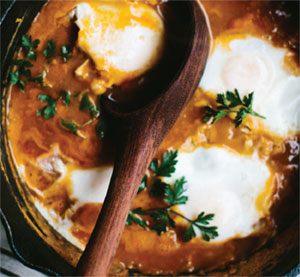 Red Lentil and Chickpea
Breakfast Stew
Red Lentil and Chickpea
Breakfast Stew
Serves 4-6
2 tablespoons unsalted butter
1 medium-size onion, diced
1-1/2 teaspoons sea salt, divided, plus more as needed
1 teaspoon ground cumin
1 teaspoon ground coriander
1/2 teaspoon ground ginger
1/2 teaspoon ground cinnamon
1 teaspoon paprika
2 tablespoons tomato paste
1 cup dried red lentils, picked over and rinsed
1 can chickpeas, drained and rinsed
4 cups low-sodium chicken or vegetable stock
4 to 6 large eggs
In a large Dutch oven, melt the butter over medium-high heat. Add the onion and 1/2 teaspoon sea salt, then sauté until tender, about 5 minutes. Stir in the cumin, coriander, ginger, cinnamon, paprika and tomato paste. Cook, stirring, for 1 minute more to toast the spices.
Add the lentils, chickpeas, stock and remaining 1 teaspoon sea salt. Bring to a simmer and gently boil until the lentils are tender and the stew has thickened, 20 to 30 minutes.
Taste and adjust the seasoning as needed.
Crack the eggs into the stew, add a pinch of sea salt to each one, then cover with a lid and cook until the whites are nearly cooked through. They will continue to cook as they sit in the warm stew. Serve while warm.
The stew can be made up to 3 days in advance; warm over the stove, then add and cook the eggs when ready to serve.